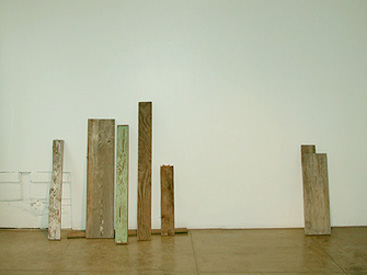
Born in 1956 in Cheshire (UK). Lives and works in London (UK)

2004
Installation, wood, transparent string.
144,5 x 306,5 x 62 cm
Year of Purchase: 2008
If many of her recent works (Measuring Liberty with a Dollar, 2007; Chomskian Abstract, 2008) express a predominant attraction for the political role that the artist may play, Cornelia Parker has always been fascinated by explosions, whether natural (cosmic) or produced by manís mastery over the physical world (the atomic bomb). She gained notoriety with Cold Dark Matter: An Exploded View (1991), an installation based on the explosion of a garden shack: various pieces of rubble (childrenís toys, garden tools, household objects, debris of books, etc.) hang from the ceiling by clear threads and, illuminated by a central light, form an evocative spatial constellation which projects shadows haunting the space and transforming the detonation into an atmosphere of calm and meditation.
Passing between the macro- and the microcosm, Cornelia Parker also displays a fondness for life signs left by renowned twentieth-century thinkers, philosophers, and writers. As she visits museums dedicated to their life and work, the artist uses macro photography to capture various objects that used to belong to them and assembles an incongruous inventory sampling multifarious aspects of their lives: BrontŽan Abstract (Charlotte BrontŽís pincushion), 2006, shows tiny puncture holes which, in turn, resemble a mirific constellation; in Einsteinís Abstracts, 1999, closely observed chalk traces on Einsteinís blackboard form fantastic cosmogonies.
Cornelia Parker doesnít so much produce as she recuperates objects, manipulating them in order to intervene at the end of their lives, according them another existence. The artist orients our perception by insisting less on the testimonial value of these objects than on the imagined short-cut between their intrinsic meaning and the marks of the life that fashioned them, thus bridging collective knowledge and individual perception. As a result, the ambivalence of words and their evocative power are at work in the artistís approach where verbal and visual associations set imagination in motion. It is therefore significant to note that the title of one of her pieces, Transitional Object II (2008), makes explicit reference to the notion of the transitional object of British psychoanalyst Donald Winnicott, which Lacan would later flesh out with ďobjet petit aĒ to define the object of desire.
Shadow of a Doubt is an installation composed of seven wooden beams salvaged from a Texan ghost town and propped against the exhibition wall. At a closer look, the beams seem at rest, a group of sleepers, animated by a strange levitation since none of them actually touches the wall. The ghostly dimension is not new to Parkerís work. Blue Shift (2001) presents the nightgown worn by Mia Farrow in Polanskiís Rosemaryís Baby in a light box, playing on a spectral connotation. While itís hard not to think about Hitchcockís film Shadow of a Doubt (1943), the relevant connection lies more in the psychological value of the plot uniting the characters: the skeptical admiration of a niece who suspects her uncle to be guilty of murdering rich widows. As Parker puts it: ďAt the heart of Art, there is always the idea of re-evaluation, of challenging the gaze that we direct at the world,Ē which in turn makes us think about the fragmented understanding of what one sees and of the psychological and physical mechanisms that obliterate access to objective reality of things.
Cťcilia Bezzan